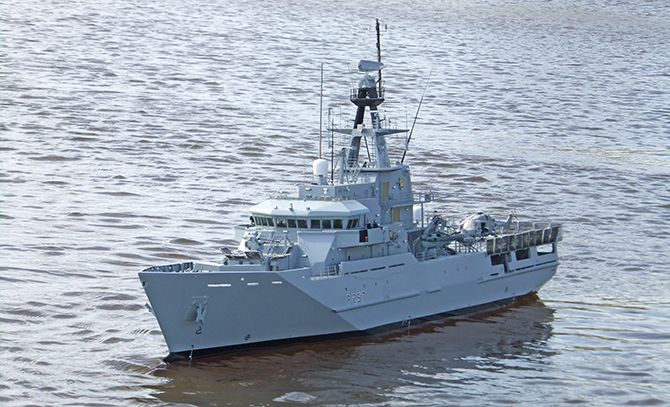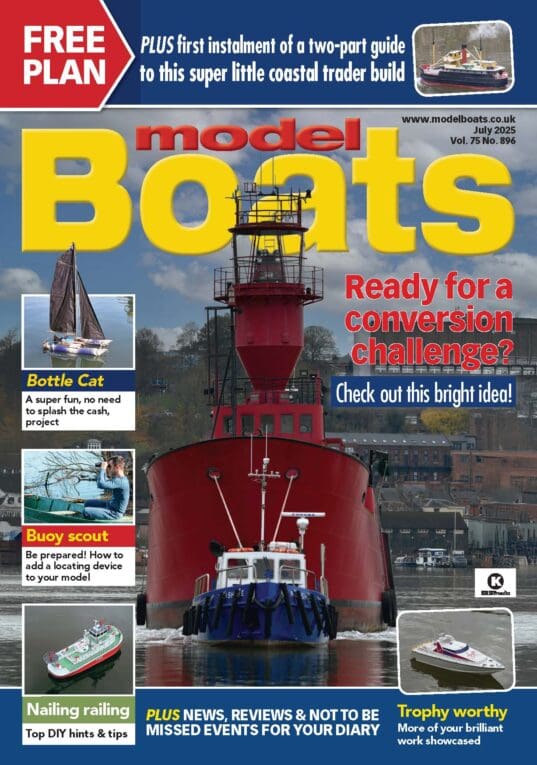





By David Reith
I’ve always had a passion for warships, having built several such models over the past 40 years, graduating from kits to semi-kits using Sirmar or Fleetscale hulls, and then to being able to scratch-build my own hulls and fittings.
Some year’s ago, Paul Beckley started Sirmar and his passion for model warships was very motivating. He took the time to teach me how to make a GRP hull and cold mould resin fittings, so the hobby became even more enjoyable.
Enjoy more Model Boats Magazine reading in the monthly magazine.
Click here to subscribe & save.
This three year project for HMS Clyde (at 1:48 scale) appealed because of the ship’s stark hull lines. Having seen the Sirmar 1:48 scale hull at a Surface Warship Event in Oct 2011, this had me thinking; ‘I like that’ and ‘I want one’. This hull is for the Batch Two version of the River Class offshore patrol vessels and it has a flight deck suitable for Merlin and Lynx helicopters, by coincidence just as Airfix was releasing its 1:48 scale kit. The hull was ordered from Barry, who now owns Sirmar, in December 2011 and it arrived three weeks later. I was already aware that the hull was a customer return with some minor gel coat faults and priced accordingly. There was actually nothing that could not be easily corrected, so referring to the Jecobin drawings, planning could begin and in particular what features would be functioning. This is a large model at 1:48 scale so the following were all practicable.
- Bow thruster
- Stern thruster
- Anchor winch (a modified mini-servo).
- Boat davits (a mini-servo with pushrods, the boat configured to allow it to swing out).
- Working LED lights (for navigation, mast, superstructure, bridge, quarter deck and even helicopter interior).
- Helicopter (tail and main blades rotate using pager motors; their power cables are disguised as the refuelling hose).
- Flight deck (manual folding of safety nets).
- Radars (rotate using robot pile-geared motors).
- 30mm gun (traverses slowly and sounds at the end of its travel).
- Sound system (helicopter start-up and take-off).
- Water pumps (engine room coolant discharges, stern thruster and fire monitors).
Construction
The first step was to cut out the quarter deck scupper openings and then the intakes below the waterline which were boxed internally and etched brass grills fitted over the openings. My cunning plan was to use these intakes as water suction inlets for the fire monitors, engine coolant outlets and the stern thruster. The rudders, hull rubbing strakes and stabilisers were constructed using layers of ABS card, glued and shaped to size, then used as masters in rubber moulds to cold cast the actual versions. The framework for the quarter deck and the main deck was then installed.
As you will have gathered, having so many working features meant that the wiring loom had to be carefully planned, keeping the power cables away from the R/C signal wires. The initial plan was to have two 6V 10 amp SLA batteries in the hull, with a power grid for the port side and similar for starboard. However, during first trials it was discovered that 6V was not enough for the MFA 800 size drive motors, so back to the drawing board. In the end, this meant having a 12V propulsion motor supply and a 6V supply for the radio and auxiliary systems, so it all ended up as two wiring looms with approximately 25 metres of various cable sizes, all suitably configured to make everything work. The internal protocol is: power on the port side and R/C signals to starboard.
Propulsion
Bob Jenner of the SWA who had already built an HMS Clyde and Colin (on one of the forums) who is building the same vessel, suggested MFA Torpedo 800s together with Prop Shop propellers, these being amongst the best that you can buy, and they look good as well. The propshafts were self-made using 6mm stainless steel for the shafts themselves running in bronze bearings within brass tubes. The supporting A and P frames were machined from bronze.
Superstructure & fittings
The superstructure was constructed from 2mm plastic (styrene) sheet, as were the quarter and main decks, laid over the wooden frames. For the fittings, masters were made for the doors, vents, bulkhead lights etc. and moulds taken so they could all be cast in resin, ad-infinitum, but some fittings such as the capstan and anchors were individually made from brass and aluminium. Purchased off the shelf were the Prop Shop propellers, Raboesch bow thruster, Technobots sound unit, ACTion Servo Morph, Airfix 1:48 scale helicopters (Merlin & Lynx) and Robbe water pumps.
Conclusion
HMS Clyde sails very well, now running on 12V rather than 6V. The model can turn in her own length when using the motors one ahead and one astern. In general manoeuvring it answers the helm well, but the sound output is a bit muffled which will be looked at later. The mechanical Raboesch bow thruster is a bit noisy but this may be due to the vast internal ‘sound box’ volume of the hull. It is, of course, a big model, but this means that its displacement is sufficient to carry the large(ish) batteries and have the numerous working features. The Jecobin plans are outstanding, although I understand that Gerry Hitch is perhaps now looking to retire, which would be a shame. Finally, Being in the Surface Warship Association has been a great help with constructive advice from its members, and through the internet forums I have also been able to discuss building queries with a number of other enthusiasts.





